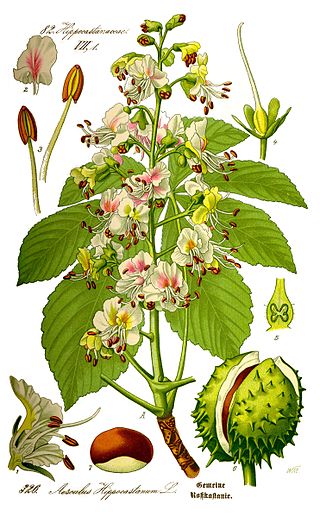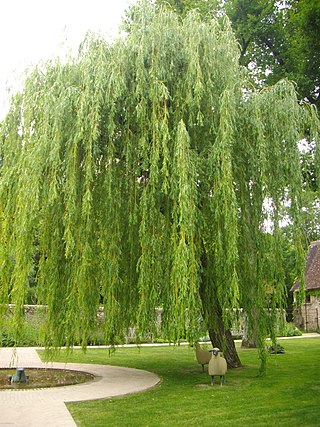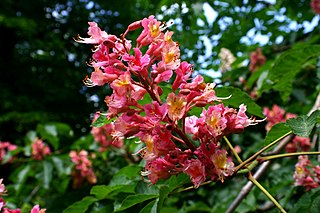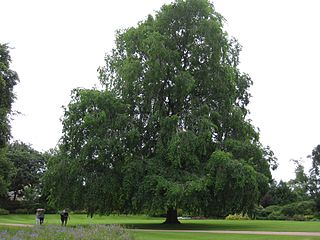Related Research Articles

Cercis canadensis, the eastern redbud, is a large deciduous shrub or small tree, native to eastern North America from southern Michigan south to central Mexico, west to New Mexico. Species thrive as far west as California and as far north as southern Ontario. It is the state tree of Oklahoma. The prevalence of the so-called "Columbus strain" has seen the residents of Columbus, Wisconsin, embrace the plant in their city's identity. Known as the "Redbud City," the town hosts "Redbud Day" annually the Saturday before Mother's Day, organizing a variety of themed events to recognize the tree.

Aesculus pavia, known as red buckeye or firecracker plant, is a species of deciduous flowering plant. The small tree or shrub is native to the southern and eastern parts of the United States, found from Illinois to Virginia in the north and from Texas to Florida in the south. It is hardy far to the north of its native range, with successful cultivation poleward to Arboretum Mustila in Finland.

The genus Aesculus, with species called buckeye and horse chestnut, comprises 13–19 species of flowering plants in the family Sapindaceae. They are trees and shrubs native to the temperate Northern Hemisphere, with six species native to North America and seven to 13 species native to Eurasia. Several hybrids occur. Aesculus exhibits a classical Arcto-Tertiary distribution.

Aesculus hippocastanum, the horse chestnut, is a species of flowering plant in the maple, soapberry and lychee family Sapindaceae. It is a large, deciduous, synoecious (hermaphroditic-flowered) tree. It is also called horse-chestnut, European horsechestnut, buckeye, and conker tree. It is not to be confused with the sweet chestnut or Spanish chestnut, Castanea sativa, which is a tree in another family, Fagaceae.

Salix babylonica is a species of willow native to dry areas of northern China, but cultivated for millennia elsewhere in Asia, being traded along the Silk Road to southwest Asia and Europe.

Ulmus × hollandica 'Vegeta', sometimes known as the Huntingdon Elm, is an old English hybrid cultivar raised at Brampton, near Huntingdon, by nurserymen Wood & Ingram in 1746, allegedly from seed collected at nearby Hinchingbrooke Park. In Augustine Henry's day, in the later 19th century, the elms in Hinchingbrooke Park were U. nitens. Richens, noting that wych elm is rare in Huntingdonshire, normally flowering four to six weeks later than field elm, pointed out that unusually favourable circumstances would have had to coincide to produce such seed: "It is possible that, some time in the eighteenth century, the threefold requirements of synchronous flowering of the two species, a south-west wind", "and a mild spring permitting the ripening of the samaras, were met."

The putative hybrid cultivar Ulmus × hollandica 'Serpentina' is an elm of unknown provenance and doubtful status. Henry identified it as intermediate between U. glabra and U. minor, a view accepted by Bean and by Melville, who believed that the specimens at Kew bearing the name 'Serpentina' were U. glabra "introgressed by U. carpinifolia" [: U. minor] and were similar to but "distinct from 'Camperdownii'".

The Siberian Elm cultivar Ulmus pumila 'Pendula' is from northern China, where it is known as Lung chao yü shu. It was classified by Frank Meyer in Fengtai in 1908, and introduced to the United States by him from the Peking Botanical Garden as Weeping Chinese Elm. The USDA plant inventory record (1916) noted that it was a "rare variety even in China". It was confirmed as an U. pumila cultivar by Krüssmann (1962).

The American elm cultivar Ulmus americana 'Pendula' was originally listed by William Aiton in Hort. Kew, 1: 320, 1789, as U. americana var. pendula, cloned in England in 1752 by James Gordon. From the 1880s the Späth nursery of Berlin supplied a cultivar at first listed as Ulmus fulva (Michx.) pendulaHort., which in their 1899 catalogue was queried as a possible variety of U. americana, and which thereafter appeared in their early 20th-century catalogues as U. americana pendula. The Scampston Elm, Ulmus × hollandica 'Scampstoniensis', in cultivation on both sides of the Atlantic in the 19th and 20th centuries, was occasionally referred to as 'American Weeping Elm' or Ulmus americana pendula. This cultivar, however, was distinguished by Späth from his Ulmus americana pendula.
The Wych Elm cultivar Ulmus glabra 'Pendula Variegata' was first described in 1850, and later by J. F. Wood in The Midland Florist and Suburban Horticulturist (1851) as U. montana pendula variegata, the 'broad-leaved variegated weeping mountain elm', and was said by him to have originated in and been distributed by the Pontey nursery of Kirkheaton, Huddersfield, Yorkshire. It was listed by Hartwig & Rümpler in Illustrirtes Gehölzbuch (1875) as Ulmus montana (:glabra) var. pendula variegataHort.

Aesculus × carnea, or red horse-chestnut, is a medium-sized tree, an artificial hybrid between A. pavia and A. hippocastanum (horse-chestnut). Its origin uncertain, probably appearing in Germany before 1820. It is a popular tree in large gardens and parks; and is even present in Hyde Park, London.

Weeping trees are trees characterized by soft, limp twigs. This characterization may lead to a bent crown and pendulous branches that can cascade to the ground. While weepyness occurs in nature, most weeping trees are cultivars. Because of their shape, weeping trees are popular in landscaping; generally they need a lot of space and are solitary so that their effect is more pronounced. There are over a hundred different types of weeping trees. Some trees, such as the cherry, have a variety of weeping cultivars. There are currently around 550 weeping cultivars in 75 different genera, although many have now disappeared from cultivation.

Ulmus × hollandica 'Wentworthii Pendula', commonly known as the Wentworth Elm or Wentworth Weeping Elm, is a cultivar with a distinctive weeping habit that appears to have been introduced to cultivation towards the end of the 19th century. The tree is not mentioned in either Elwes and Henry's or Bean's classic works on British trees. The earliest known references are Dutch and German, the first by de Vos in Handboek tot de praktische kennis der voornaamste boomen (1890). At about the same time, the tree was offered for sale by the Späth nursery of Berlin as Ulmus Wentworthi pendulaHort.. The 'Hort.' in Späth's 1890 catalogue, without his customary label "new", confirms that the tree was by then in nurseries as a horticultural elm. De Vos, writing in 1889, states that the Supplement to Volume 1 includes entries announced since the main volume in 1887, putting the date of introduction between 1887 and 1889.

Aesculus indica, commonly known as the Indian horse-chestnut or Himalayan horse chestnut, is a species of deciduous broad-leaved tree in the family Sapindaceae.

Acer palmatum, commonly known as Japanese maple, palmate maple, or smooth Japanese maple (Korean: danpungnamu, 단풍나무, Japanese: irohamomiji, イロハモミジ, or momiji,, is a species of woody plant native to Korea, Japan, China, eastern Mongolia, and southeast Russia. Many different cultivars of this maple have been selected and they are grown worldwide for their large variety of attractive forms, leaf shapes, and spectacular colors.
Acer platanoides 'Pendulum', or weeping Norway maple, is a weeping tree and a cultivar of Acer platanoides, the Norway maple. It was first found by Niemetz at Timișoara, Romania in 1901. No trees are known to survive of this cultivar.
Acer negundo 'Pendulum', or weeping boxelder maple, is a weeping tree and a cultivar of Acer negundo, the boxelder maple. It was first described by Fritz Kurt Alexander von Schwerin in 1896. No trees are known to survive of this cultivar.
Amorpha fruticosa 'Pendula', or Weeping Desert False Indigo, was a weeping shrub and a cultivar of Amorpha fruticosa, the Desert False Indigo. It was first described in 1868 by Élie-Abel Carrière from France. No trees are known to survive of this cultivar. Apart from the clone found in France it also seems to have been reported from the wild in Florida.
Aspidosperma quebracho-blanco 'Pendula', or weeping white quebracho, is a weeping tree and a cultivar of Aspidosperma quebracho-blanco, the White Quebracho. It was first described by Spegazzini from Santiago del Estero, Argentina in 1910. No trees are known to survive of this cultivar.
Betula pubescens 'Pendula', or Weeping Downy Birch, is a weeping tree and a cultivar of Betula pubescens, the Downy Birch. It was first described by Schelle in 1903. No trees are known to survive of this cultivar.
References
[2] ^ Graham Brown (3 June 2023). Angus Plantsman Joe conquers mystery of Weeping Red Chestnut feared extinct for a Century. The Courier. Dundee. Retrieved from the original 19 November 2023.
- 1 2 Govaerts, R., Michielsen, K. & Jablonski, E. (2011). Untraced Weeping Broadleaf cultivars: an overview. Belgische Dendrologie Belge Archived 2012-03-22 at the Wayback Machine 2009: 19-30.